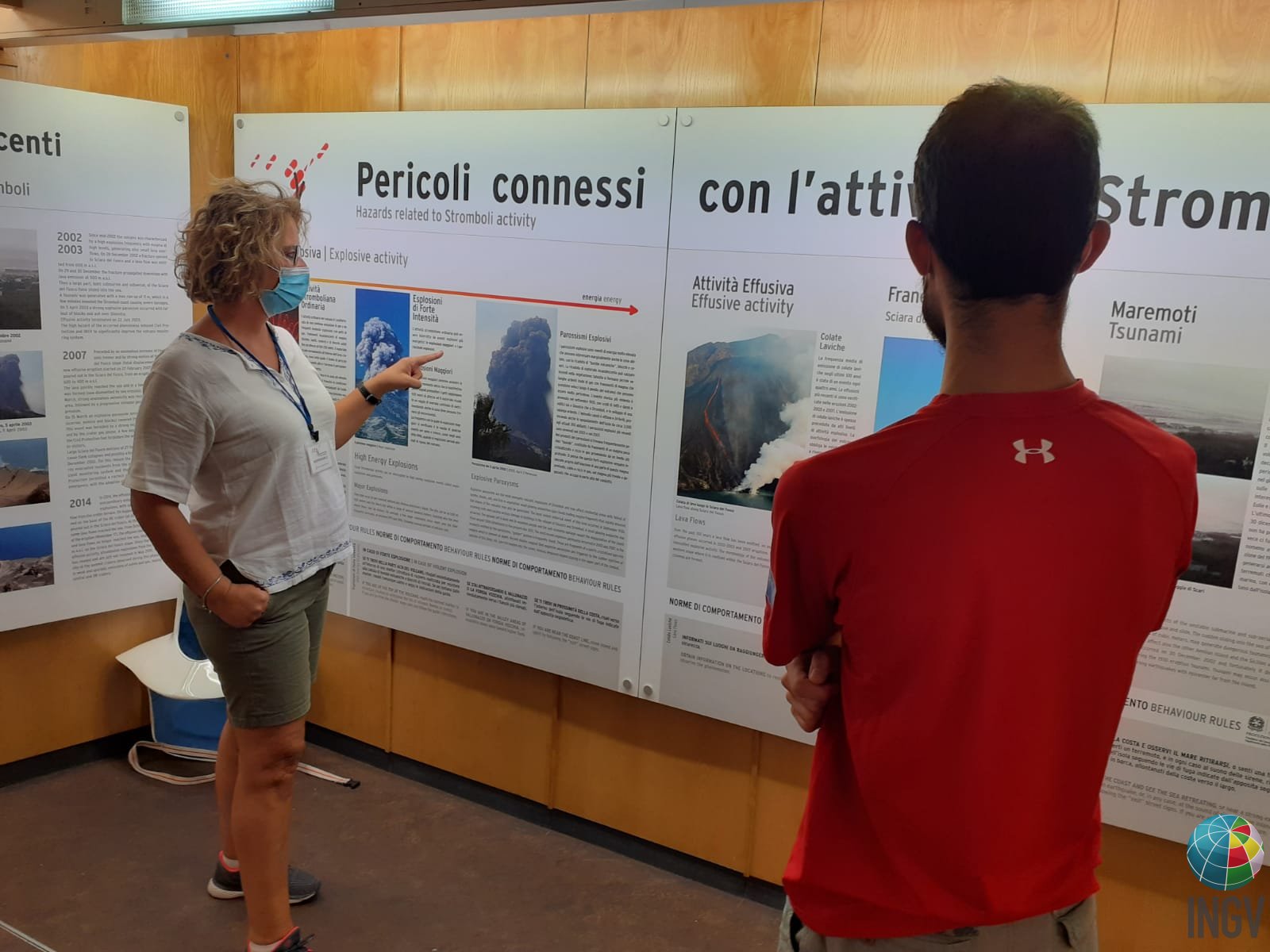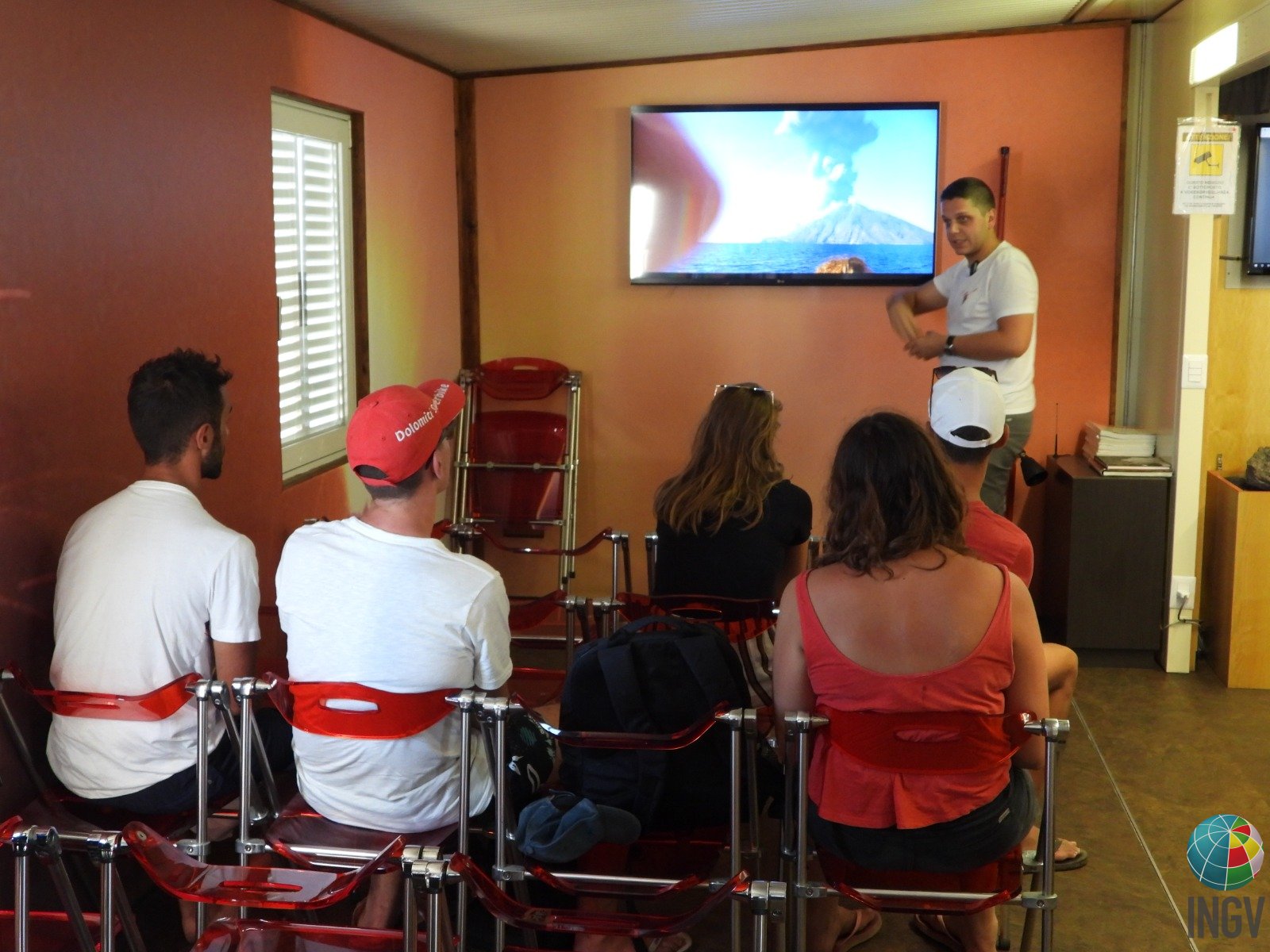Nell’ambito degli accordi di collaborazione tra il Dipartimento di Protezione Civile e l’INGV, una parte di essi è dedicata alla comunicazione intesa sia come divulgazione che come formazione, per sapere come agire al meglio in caso di eventi. Sia il DPC che l’INGV, infatti, riconoscono alla comunicazione lo status strategico di strumento di mitigazione del rischio. Per capire quali sono i canali e i destinatari di queste attività così importanti abbiamo intervistato Rosella Nave, geologa dell’INGV che si occupa di comunicazione della scienza anche in collaborazione con il DPC.
 Rosella, che cos’è il WP12 nell’ambito della convenzione tra il Dipartimento di Protezione Civile e l’INGV?
Rosella, che cos’è il WP12 nell’ambito della convenzione tra il Dipartimento di Protezione Civile e l’INGV?
Il WP12 è il working package, cioè il “contenitore”, all’interno del quale sono incluse le attività di comunicazione, formazione e divulgazione legate ai temi della pericolosità sismica, vulcanica e da maremoto. Queste attività, riconosciute come fondamentali in quanto strumento di mitigazione del rischio, sono indicate nell'Accordo Quadro tra INGV e DPC e vengono definite da un gruppo di lavoro i cui componenti sono di entrambe le parti.
All’interno del WP12 ci sono 7 sub-task che riguardano progetti ventennali come EDURISK, che prevede la formazione ai docenti e la promozione di attività didattiche volte alla maggiore conoscenza dei rischi da pericoli naturali come sono i terremoti, l’attività vulcanica e i maremoti.
C’è poi “Io non Rischio”, progetto dedicato al volontariato che è coinvolto in una campagna di comunicazione nazionale sulle buone pratiche di protezione civile con l’obiettivo di attirare l'attenzione dei cittadini sulle corrette azioni da adottare per ridurre gli impatti degli eventi naturali avversi.
Altre sub-task sono dedicate all’informazione in emergenza sismica e vulcanica, alla gestione dei social media e alla divulgazione scientifica.
Una sub-task in particolare, infatti, è quella che riguarda gli Info Point di Stromboli e Vulcano. Durante il periodo estivo, quando l’afflusso di turisti e residenti è maggiore, l’INGV mette a disposizione dei visitatori delle isole team di ricercatori per illustrare le caratteristiche del vulcanismo eoliano e i rischi ad esso connessi, in collaborazione con selezionati studenti universitari coinvolti nei turni settimanali.
Tutte queste attività hanno dei referenti dell’INGV e del DPC che le coordinano e ne monitorano svolgimento e risultati.
Che tipo di comunicazione fate agli Info Point delle Eolie?
L’attività alle Eolie è particolare in quanto Stromboli e Vulcano sono le uniche isole che hanno dei centri permanenti, seppure attivi solo in alcuni mesi dell'anno. La comunicazione è volta a illustrare le peculiarità di questi vulcani ma anche quali sono i fenomeni potenzialmente pericolosi e il loro possibile impatto.
Anche prima dell’Accordo Quadro, il DPC co-finanziava l’attività nei centri informativi, riconoscendo loro una valenza importantissima poiché rappresentano un presidio d’informazione sul territorio soprattutto durante i mesi estivi, quando l’attività escursionistica dei turisti e dei residenti è particolarmente vivace.
 Perché questo tipo di attività di comunicazione è così importante?
Perché questo tipo di attività di comunicazione è così importante?
In primo luogo perché è una comunicazione che riguarda il pubblico generico. Questo presuppone che sia calibrata attraverso strumenti e modalità idonei che la rendano chiara e comprensibile a tutti.
In secondo luogo perché l’organizzazione stessa delle attività di comunicazione dei turnisti vede loro scambiarsi esperienze e conoscenze in un laboratorio di sapere dove si incontrano ricercatori di differente provenienza: nei Centri collaborano anche gli studenti delle università italiane, quando possibile.
Chi sono, in dettaglio, i destinatari di queste attività di comunicazione?
Il pubblico è ampio, si va dal turista che a malapena sa che si trova su un vulcano attivo a chi è appassionato di vulcanologia e viene da noi per avere informazioni, mappe e delucidazioni.
Quali sono gli obiettivi di questo tipo di comunicazione?
L'obiettivo della comunicazione scientifica portata avanti dall’INGV ha due scopi fondamentali.
In primo luogo, come Ente di Ricerca, l’INGV promuove la cultura scientifica e le Scienze della Terra in particolare, perchè benchè non siano molto scelte da un punto di vista di carriera universitaria, sono estremamente importanti per il progresso della conoscenza delle caratteristiche naturali del nostro Paese.
In secondo luogo, questo tipo di comunicazione ha come obiettivo la salvaguardia di vite umane attraverso una maggiore consapevolezza di quelle che sono le caratteristiche del territorio; per questo è riconosciuta come strumento strategico di mitigazione dei rischi.
Al fine di raggiungere questi obiettivi i canali utilizzati sono differenti, e uno di questi è rappresentato proprio dagli Info Point. Oggi siamo riconosciuti come un riferimento nella comunicazione sia dl pubblico generico sia dall'ufficiale di Protezione Civile locale e da un pubblico più esperto.
Per concludere, qual è secondo te la chiave di una comunicazione scientifica efficace?
Ce ne sono più di una: il ricercatore deve mettersi in discussione e non tradire mai la vocazione che ha l’INGV nel condividere con il pubblico quello che fa e in che modo, caratteristica che l’Ente ha nel suo DNA.
Una comunicazione scientifica efficace riesce a divulgare nel modo più semplice possibile a un pubblico ampio non solo i risultati della ricerca scientifica ma anche i benefici che questa apporta nell'ambito delle Scienze della Terra. A mio avviso, l'inclusione del pubblico come parte fondamentale della ricerca scientifica è una delle caratteristiche più importanti di una comunicazione scientifica efficace.
Scientific Communication, a strategic tool in mitigation of natural hazards
As part of the collaboration agreements between the Italian Civil Protection Department and the INGV, a part of them is dedicated to communication intended both as disclosure and as training, to know how to best act in case of events. Both DPC and INGV, in fact, recognize the strategic status of communication as a risk mitigation tool. To understand the channels and recipients of these important activities, we interviewed Rosella Nave, a geologist from INGV who deals with science communication also in collaboration with the DPC.
Rosella, what is WP12 in the context of the agreement between the Department of Civil Protection and the INGV?
The WP12 is the working package, that is the "container” within which communication, training and dissemination activities related to the themes of seismic, volcanic and tsunami hazard are listed. These activities, recognized as fundamental risk mitigation tool, are indicated in the Framework Agreement between INGV and DPC and are defined by a working group whose members belong to both parties.
Within the WP12 there are 7 sub-tasks ranging twenty-year projects such as EDURISK, which provides training for teachers and the promotion of educational activities aimed at better knowing the risks from natural hazards such as earthquakes, volcanic activity and tsunamis.
Then there is "Io non Rischio", a project dedicated to volunteering that is involved in a national communication campaign on good civil protection practices where the attention of citizens is to be drawn on the correct actions to be taken to reduce impacts.
Other sub-tasks are dedicated to information in seismic and volcanic emergencies, social media management and dissemination.
A particular sub-task, in fact, is the one concerning the Info Points of Stromboli and Vulcano. During the summer, when the influx of tourists and residents is greater, INGV makes specialized teams of researchers available to visitors to the islands to illustrate the characteristics of Aeolian volcanism and the risks associated with it.
All these activities have INGV and DPC contacts who coordinate them and monitor their results
What kind of communication do you do at the Info Points of the Aeolian Islands?
Activity in the Aeolian Islands is particular as Stromboli and Vulcano are the only islands that have permanent centers, although active only in some months of the year. The communication is aimed at illustrating the peculiarities of these volcanoes but also what are the potentially dangerous phenomena that could occur.
Even before the Framework Agreement, the DPC co-financed the activity in the information centers, recognizing them as a very important value since they represent a strategic point of information on the territory especially during the summer months, when the excursion activity of tourists and residents is particularly lively.
Why is this type of communication activity so important?
Firstly, because it is a communication that concerns the general public. This presupposes that it is calibrated through suitable tools and methods that make it clear and understandable to all.
Secondly, because the very organization of the communication activities of INGV researchers working at the Info Points sees them exchanging experiences and knowledge in a laboratory of knowledge where scientists from different backgrounds meet: students from Italian Universities also collaborate in the Centers, whenever possible.
Who are, in detail, the recipients of these communication activities?
The public is broad, ranging from the tourist who barely knows that he is on an active volcano to those who are passionate about volcanology and come to us for information, maps and explanations.
What are the purposes of this type of communication?
The purposes of scientific communication carried out by the INGV has two fundamental aims.
First of all, as a research institution, INGV promotes scientific culture and the Earth Sciences in particular, because, although they are not very chosen from a university career point of view, they are extremely important for the advancement of knowledge of the natural characteristics of our Country.
Secondly, this type of communication aims to safeguard human lives through a greater awareness of the characteristics of the territory; for this reason it is recognized as a strategic risk mitigation tool.
In order to achieve these objectives the channels used are different, one of these is represented by the Info Points.
Today we are recognized as a reference in communication by the general public as well as the local Civil Protection officer and a more experienced public.
Finally, what do you think is the key to effective scientific communication?
There are more than one: the researcher must question himself as well as never betray the vocation that INGV has in sharing with the public what it does and in what way, a characteristic that the institution has in its DNA.
Effective scientific communication manages to disseminate in the simplest way possible not only the results of scientific research but also the benefits it brings in the field of Earth Sciences to a wide audience. In my opinion, the inclusion of the public as a fundamental part of scientific research is one of the most important characteristics of effective scientific communication.



